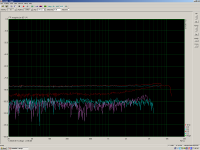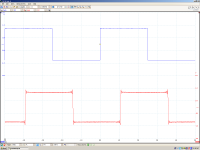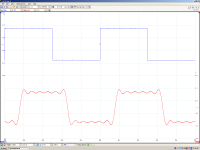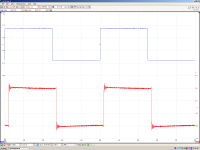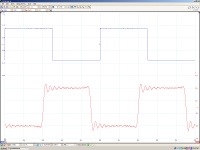Dave-Because it's just not that important.
I can easily generate one if you want, but what would you deduce from it? Simple harmonic distortions from gadgets like these are waaaay less than any speaker system you'd use them with. And there are a few experts that believe harmonic distortion measurements are completely meaningless anyways.
Cheers,
Dave.
If you hadn't added not just one but TWO smileys, then I (and I believe, 95% of those who post on DIYaudio) would find those sentiments vile beyond words.
But I am sure you are joking because you seem technically adept and must know the details because you kindly offer to produce the requested information. And, can you also run square waves at 200 and 2000 Hz (and because of my choice of Hz's, I am sure you see that I have a modest acquaintance with testing too)?
Funny thing is that I often find myself arguing there is sometimes needless attention to minute distortions in light of speaker imperfections. Never the less, "where's the meat."
Thanks in advance.
Ben
Dave -So, you want to see THD for a 1khz sinewave and a scope photo of 200/2000Hz square waves?
Will do.
Dave.
Many thanks for your follow-up.
Let me "think out loud" about a wish-list for a bit:
THD (or even better, spectrum analysis) of a 1000Hz sine sounds good, and at full bits and at low bits levels, if you see any difference
scope-like pictures of 200 and 2000 Hz square waves, with enough resolution to see any supersonic wiggles (and if the pix look gawd-awful, I wonder if the spectral composition is pretty good anyway)
a dB figure for noise-garbage floor, relative to full output (and relative to the noise in your measuring system if commensurate)
I wonder what a DSP output past "clipping" looks like
Naturally, we'd also need some background on power supplies, shielding, or anything you think matters to know.
Thanks.
Ben
Last edited:
Okay, well here's one to start you off.
This is an ARTA distortion sweep with input/output levels at approximately 0.5VRMS.
Regarding noise floor: I've posted numerous measurements in the past few years showing it. And another just the other day on the miniDSP forum.
Regardless, you'd have to specify which platform since the 2x4 and 2x8 are quite different in this respect.
Dave.
This is an ARTA distortion sweep with input/output levels at approximately 0.5VRMS.
Regarding noise floor: I've posted numerous measurements in the past few years showing it. And another just the other day on the miniDSP forum.
Regardless, you'd have to specify which platform since the 2x4 and 2x8 are quite different in this respect.
Dave.
Attachments
Dave -
Many thanks. Much appreciated.
The square waves are as good as anybody could ask for*. The ripple on the 2kHz wave seems to be around 22kHz, which should be no surprise for a miniDSP 2x4 sampling rate esp. if tested with computer hardware.
But could you explain the ARTA traces, please.
As far as noise/garbage floor, I'd be happy just to hear the number dB below .9 volts and if much of that is at power-line frequencies.
I am curious about both the pedestrian 2x4 and the high-octane 2x8.
My application (a corner folded horn, mid-wall OB, and mid-floor large panels) might require two DSPs in series to produce enough (and long enough) time delays. Is it correct to suppose that if the signal is kept digital end to end, the total harm is no more than with a single DSP?
Ben
*sure, if you've tested a DC-to-X-ray pre-amp, you've seen better, but not a helpful comparison
Many thanks. Much appreciated.
The square waves are as good as anybody could ask for*. The ripple on the 2kHz wave seems to be around 22kHz, which should be no surprise for a miniDSP 2x4 sampling rate esp. if tested with computer hardware.
But could you explain the ARTA traces, please.
As far as noise/garbage floor, I'd be happy just to hear the number dB below .9 volts and if much of that is at power-line frequencies.
I am curious about both the pedestrian 2x4 and the high-octane 2x8.
My application (a corner folded horn, mid-wall OB, and mid-floor large panels) might require two DSPs in series to produce enough (and long enough) time delays. Is it correct to suppose that if the signal is kept digital end to end, the total harm is no more than with a single DSP?
Ben
*sure, if you've tested a DC-to-X-ray pre-amp, you've seen better, but not a helpful comparison
Last edited:
The square waves were captured via my Picoscope 6. Not technically "computer hardware" since it's not a soundcard-based system. The results are consistent with Gibbs phenomenon for that sampling rate.
The ARTA plot is from the STEPS (stepped sine-wave) application which is a simple two-channel differential measurement where the excitation signal output is applied to the device-under-test and also looped back to one channel soundcard input. The other channel input monitors the device-under-test. What you see is just a simple relative signal plot. In this case there is only measurable distortion of the 2nd/3rd harmonic....the 4th/5th plot are essentially meaningless and buried in the noise floor. If you're more interested in a percentage figure for THD/HD, just simply convert the level on the left.
I can't see any reason to utilize two of the standard miniDSP units in "series" to create long delays. Unnecessary A/D..D/A..A/D..D/A..etc, etc conversions. Your best bet in that case would be to use the miniSHARC platform or maybe a device from some other manufacturer.
Cheers,
Dave.
The ARTA plot is from the STEPS (stepped sine-wave) application which is a simple two-channel differential measurement where the excitation signal output is applied to the device-under-test and also looped back to one channel soundcard input. The other channel input monitors the device-under-test. What you see is just a simple relative signal plot. In this case there is only measurable distortion of the 2nd/3rd harmonic....the 4th/5th plot are essentially meaningless and buried in the noise floor. If you're more interested in a percentage figure for THD/HD, just simply convert the level on the left.
I can't see any reason to utilize two of the standard miniDSP units in "series" to create long delays. Unnecessary A/D..D/A..A/D..D/A..etc, etc conversions. Your best bet in that case would be to use the miniSHARC platform or maybe a device from some other manufacturer.
Cheers,
Dave.
Dave -
Many thanks again. I guess your good data have moved me from "DSP agnostic" to nearly "DSP believer."
I suppose my critical instincts would still lead me to the kind of listening test that used to be done with tape recorders: you send the signal through several "generations" to multiply the shortcomings of each stage. For sure, you can dub CDs endlessly with no loss, I think. But a bit different with ADCs and DACs in the units.
About "series" connected DSP, I meant connecting the boards digitally, without any conversions in the middle. Not sensible?
Again, I appreciate your patience and help.
Ben
Many thanks again. I guess your good data have moved me from "DSP agnostic" to nearly "DSP believer."
I suppose my critical instincts would still lead me to the kind of listening test that used to be done with tape recorders: you send the signal through several "generations" to multiply the shortcomings of each stage. For sure, you can dub CDs endlessly with no loss, I think. But a bit different with ADCs and DACs in the units.
About "series" connected DSP, I meant connecting the boards digitally, without any conversions in the middle. Not sensible?
Again, I appreciate your patience and help.
Ben
Probably not. The inputs/outputs of the MiniDSP modules are limited to 900mV, and that's right in the neighborhood of where most amplifiers would be delivering their rated power. So, if your MiniDSP modules are feeding the amplifiers directly I'd say your chances of clipping the MiniDSP outputs are near zero. This is what I was referring to with the "well considered maximum levels" comment. Unlike the DCX (and other commercial units) a multi-channel post-volume control is not necessary with the MiniDSP units.
The Emotiva power-amps have 32db voltage gain (which is a bit more than usual) so your MiniDSP working voltage levels would be a bit less than they would otherwise and reduce the chances of clipping even further.
Obviously, if programming large EQ boosts in the MiniDSP you might get into trouble, so you have to be aware.
Cheers,
Dave.
Hi Davey
Could you confirm if the volume levels would differ if the amplifier I used downstream of a Rev B Minidsp 2x4 Balanced would be more/less using a Linn Klimax Solo amplifier? I'm a newbie to all of this and would like to confirm if I would have any gain issues when using my amplifiers with this DSP
The amplifier specs confirm:
Gain:
Single ended ................................................................ 28.6dB
Balanced ...................................................................... 22.6dB
Input impedance:
Single ended ................................................................ 7k6 Ohms
Balanced ...................................................................... 7k6 Ohms
Input level for clipping:
Balanced ...................................................................... 3.34 Vrms
Single ended ................................................................ 1.67 Vrms
Signal sensing threshold ........................................ >150uV
My Preamplifier Balanced outputs are:
+15dbV (Max) 8V peak (+15 dbv thats 5.6v?)
Thank you
Last edited:
The 2x4 Rev B unit was an earlier model that had the input hard-configured (padded) for a 2VRMS input. However, the output was still limited to 0.9VRMS....so this resulted in a nominal -7db reduction in gain.
Since your amplifier requires 1.67VRMS to achieve clipping, the miniDSP 2x4 unit will not be able to drive your amplifier to full power.
Actually a -5.3 db shortcoming. 20 * log(0.9/1.67).
Your preamp appears to have enough voltage to drive the miniDSP fully. 5.6VRMS balanced is 2.8vRMS for an unbalanced connection so you should be able to drive the miniDSP inputs to clipping.
I don't know if this setup would be acceptable for you or not. Much depends upon the efficiency of your speaker system and how loud you like to listen.
Cheers,
Dave.
Since your amplifier requires 1.67VRMS to achieve clipping, the miniDSP 2x4 unit will not be able to drive your amplifier to full power.
Actually a -5.3 db shortcoming. 20 * log(0.9/1.67).
Your preamp appears to have enough voltage to drive the miniDSP fully. 5.6VRMS balanced is 2.8vRMS for an unbalanced connection so you should be able to drive the miniDSP inputs to clipping.
I don't know if this setup would be acceptable for you or not. Much depends upon the efficiency of your speaker system and how loud you like to listen.
Cheers,
Dave.
Thanks Dave, that makes sense. So none of the MiniDSP units output more than 0.9VRMS? I was under the impression the unit I ordered was the latest version (ordered last week)
I am using BALANCED method of operation, so its actually 3.34vrms but that results in -5.3 like you said.
My speakers have a 90db efficency (2.83V/1m).
Currently, the maximum I set my preamplifier volume is 65 out of a possible 100. Usually, its around 55 though. Thats PLENTY loud enough for me
Would this become an issue at my volumes?
Cheers
I am using BALANCED method of operation, so its actually 3.34vrms but that results in -5.3 like you said.
My speakers have a 90db efficency (2.83V/1m).
Currently, the maximum I set my preamplifier volume is 65 out of a possible 100. Usually, its around 55 though. Thats PLENTY loud enough for me
Would this become an issue at my volumes?
Cheers
Last edited:
I just checked the specs of the MiniDSP, it says: (Sorry I have the version in a Box)
Maximum output level <1% THD 2Vrms (5.6Vpp) referen
ced to ground, i.e. 14dBu in balanced mode
Given it can output 14dBu in Balanced and the Klimax Solo Amplifer requires 12.6dBu (3.34 vrms) for clipping, the MiniDSP should be able to drive it to clipping, no??
Maximum output level <1% THD 2Vrms (5.6Vpp) referen
ced to ground, i.e. 14dBu in balanced mode
Given it can output 14dBu in Balanced and the Klimax Solo Amplifer requires 12.6dBu (3.34 vrms) for clipping, the MiniDSP should be able to drive it to clipping, no??
Last edited:
200/2000Hz square waves. (input blue, output red.)
Dave.
Can you do those for the 2x8 as well pretty please?
That response is a probable explanation why I do not like my 2x4, it sounds "wrong". I actually listen to a lot of square waves. 2nd and 4th order analog filters sound better, but I want steeper filters.
I just checked the specs of the MiniDSP, it says: (Sorry I have the version in a Box)
Maximum output level <1% THD 2Vrms (5.6Vpp) referen
ced to ground, i.e. 14dBu in balanced mode
Given it can output 14dBu in Balanced and the Klimax Solo Amplifer requires 12.6dBu (3.34 vrms) for clipping, the MiniDSP should be able to drive it to clipping, no??
Well, you've got me confused which unit you actually have now.
Anyways, if it's one of the newer units based on the "balanced" platform then it will output 2VRMS from an unbalanced connection scheme.
Cheers,
Dave.
Well, you've got me confused which unit you actually have now.(You said Rev B initially.)
Anyways, if it's one of the newer units based on the "balanced" platform then it will output 2VRMS from an unbalanced connection scheme.
Cheers,
Dave.
Sorru
I have the Balanced 2x4 unit in a box, I just assumed Rev b that people talk about is the new one.
Right, so it outputs 2vrms and not 0.9, so would this mean the Dsp would have no issues driving my amplifers?
Thanks, Dave.
No question the 2x8 board has nicer square waves and wider bandwidth. I suspect nobody but a dog could hear the difference... unless there are other limitations of the 2x4 which the square wave shortcomings are hinting at.
Still not the kind of needless over-excellence in square waves you'd expect from a good pre-amp (or an old Mcintosh tube amp, no kidding).
Ben
No question the 2x8 board has nicer square waves and wider bandwidth. I suspect nobody but a dog could hear the difference... unless there are other limitations of the 2x4 which the square wave shortcomings are hinting at.
Still not the kind of needless over-excellence in square waves you'd expect from a good pre-amp (or an old Mcintosh tube amp, no kidding).
Ben
Last edited:
This is not really relevant to the OP, but since I have your attention:
I have the 2/4 miniDSP in a box. It is now revB. The difference between the revA and the revB being the position of a jumper switch. RevA has 0.9v input, revB has 2.0v input. Output remains 0.9v.
My question is: If I feed the miniDSP with SPDIF, either 44.1 or 48k and either 16 or 24bits, it will directly convert that to floating point and proceed. Correct? Also, what happens if I feed the miniDSP 88.2 or 96K?
The point of order here is my computer does not have SPDIF out, so I am contemplating the purchase of a USB-SPDIF converter to avoid the DAC>ADC conversion.
Thanks.
Bob
I have the 2/4 miniDSP in a box. It is now revB. The difference between the revA and the revB being the position of a jumper switch. RevA has 0.9v input, revB has 2.0v input. Output remains 0.9v.
My question is: If I feed the miniDSP with SPDIF, either 44.1 or 48k and either 16 or 24bits, it will directly convert that to floating point and proceed. Correct? Also, what happens if I feed the miniDSP 88.2 or 96K?
The point of order here is my computer does not have SPDIF out, so I am contemplating the purchase of a USB-SPDIF converter to avoid the DAC>ADC conversion.
Thanks.
Bob
It can get a little confusing.  The earlier 2x4 units were not jumper-configurable with regard to the input pad, so you had to order either RevA (0.9 volt input) or RevB (2.0 volt input) and you were locked in. I think they quickly realized the problem with this configuration and dispensed with the two versions and started offering just one that had a jumper onboard that could be configured either way.
The earlier 2x4 units were not jumper-configurable with regard to the input pad, so you had to order either RevA (0.9 volt input) or RevB (2.0 volt input) and you were locked in. I think they quickly realized the problem with this configuration and dispensed with the two versions and started offering just one that had a jumper onboard that could be configured either way.
The "in a box" units were available either way as well.
Regarding sampling rate conversions and bit depth: Both the 2x4 and 2x8 units are analog in and analog out...primarily. However you can certainly interface via I2S lines with an extra gadget like the miniDIGI or a homebrew setup. There's an ASRC in use on almost all of the miniDSP products which will resample to 96khz or 48khz depending upon the platform. All of this is specified in the datasheets for the hardware and software/plugins on the miniDSP website.
S/PDIF inputs/outputs are not directly supported without adding some more hardware.
Cheers,
Dave.
The "in a box" units were available either way as well.
Regarding sampling rate conversions and bit depth: Both the 2x4 and 2x8 units are analog in and analog out...primarily. However you can certainly interface via I2S lines with an extra gadget like the miniDIGI or a homebrew setup. There's an ASRC in use on almost all of the miniDSP products which will resample to 96khz or 48khz depending upon the platform. All of this is specified in the datasheets for the hardware and software/plugins on the miniDSP website.
S/PDIF inputs/outputs are not directly supported without adding some more hardware.
Cheers,
Dave.
- Status
- This old topic is closed. If you want to reopen this topic, contact a moderator using the "Report Post" button.
